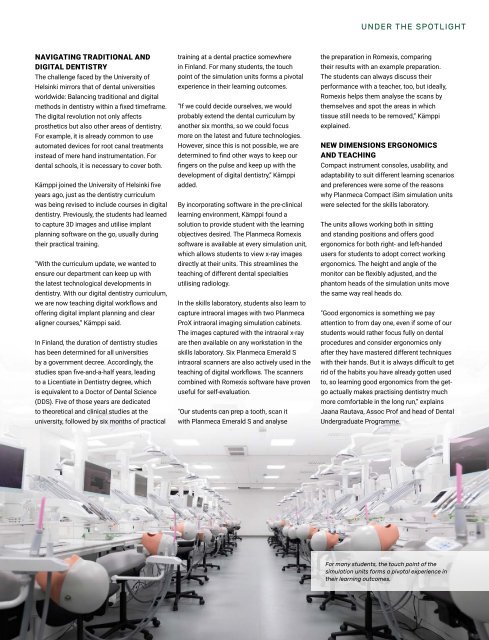Dental Asia March/April 2024
For more than two decades, Dental Asia is the premium journal in linking dental innovators and manufacturers to its rightful audience. We devote ourselves in showcasing the latest dental technology and share evidence-based clinical philosophies to serve as an educational platform to dental professionals. Our combined portfolio of print and digital media also allows us to reach a wider market and secure our position as the leading dental media in the Asia Pacific region while facilitating global interactions among our readers.
For more than two decades, Dental Asia is the premium journal in linking dental innovators
and manufacturers to its rightful audience. We devote ourselves in showcasing the latest dental technology and share evidence-based clinical philosophies to serve as an educational platform to dental professionals. Our combined portfolio of print and digital media also allows us to reach a wider market and secure our position as the leading dental media in the Asia Pacific region while facilitating global interactions among our readers.
Create successful ePaper yourself
Turn your PDF publications into a flip-book with our unique Google optimized e-Paper software.
UNDER THE SPOTLIGHT<br />
NAVIGATING TRADITIONAL AND<br />
DIGITAL DENTISTRY<br />
The challenge faced by the University of<br />
Helsinki mirrors that of dental universities<br />
worldwide: Balancing traditional and digital<br />
methods in dentistry within a fixed timeframe.<br />
The digital revolution not only affects<br />
prosthetics but also other areas of dentistry.<br />
For example, it is already common to use<br />
automated devices for root canal treatments<br />
instead of mere hand instrumentation. For<br />
dental schools, it is necessary to cover both.<br />
Kämppi joined the University of Helsinki five<br />
years ago, just as the dentistry curriculum<br />
was being revised to include courses in digital<br />
dentistry. Previously, the students had learned<br />
to capture 3D images and utilise implant<br />
planning software on the go, usually during<br />
their practical training.<br />
"With the curriculum update, we wanted to<br />
ensure our department can keep up with<br />
the latest technological developments in<br />
dentistry. With our digital dentistry curriculum,<br />
we are now teaching digital workflows and<br />
offering digital implant planning and clear<br />
aligner courses,” Kämppi said.<br />
In Finland, the duration of dentistry studies<br />
has been determined for all universities<br />
by a government decree. Accordingly, the<br />
studies span five-and-a-half years, leading<br />
to a Licentiate in Dentistry degree, which<br />
is equivalent to a Doctor of <strong>Dental</strong> Science<br />
(DDS). Five of those years are dedicated<br />
to theoretical and clinical studies at the<br />
university, followed by six months of practical<br />
training at a dental practice somewhere<br />
in Finland. For many students, the touch<br />
point of the simulation units forms a pivotal<br />
experience in their learning outcomes.<br />
"If we could decide ourselves, we would<br />
probably extend the dental curriculum by<br />
another six months, so we could focus<br />
more on the latest and future technologies.<br />
However, since this is not possible, we are<br />
determined to find other ways to keep our<br />
fingers on the pulse and keep up with the<br />
development of digital dentistry,” Kämppi<br />
added.<br />
By incorporating software in the pre-clinical<br />
learning environment, Kämppi found a<br />
solution to provide student with the learning<br />
objectives desired. The Planmeca Romexis<br />
software is available at every simulation unit,<br />
which allows students to view x-ray images<br />
directly at their units. This streamlines the<br />
teaching of different dental specialties<br />
utilising radiology.<br />
In the skills laboratory, students also learn to<br />
capture intraoral images with two Planmeca<br />
ProX intraoral imaging simulation cabinets.<br />
The images captured with the intraoral x-ray<br />
are then available on any workstation in the<br />
skills laboratory. Six Planmeca Emerald S<br />
intraoral scanners are also actively used in the<br />
teaching of digital workflows. The scanners<br />
combined with Romexis software have proven<br />
useful for self-evaluation.<br />
"Our students can prep a tooth, scan it<br />
with Planmeca Emerald S and analyse<br />
the preparation in Romexis, comparing<br />
their results with an example preparation.<br />
The students can always discuss their<br />
performance with a teacher, too, but ideally,<br />
Romexis helps them analyse the scans by<br />
themselves and spot the areas in which<br />
tissue still needs to be removed,” Kämppi<br />
explained.<br />
NEW DIMENSIONS ERGONOMICS<br />
AND TEACHING<br />
Compact instrument consoles, usability, and<br />
adaptability to suit different learning scenarios<br />
and preferences were some of the reasons<br />
why Planmeca Compact iSim simulation units<br />
were selected for the skills laboratory.<br />
The units allows working both in sitting<br />
and standing positions and offers good<br />
ergonomics for both right- and left-handed<br />
users for students to adopt correct working<br />
ergonomics. The height and angle of the<br />
monitor can be flexibly adjusted, and the<br />
phantom heads of the simulation units move<br />
the same way real heads do.<br />
"Good ergonomics is something we pay<br />
attention to from day one, even if some of our<br />
students would rather focus fully on dental<br />
procedures and consider ergonomics only<br />
after they have mastered different techniques<br />
with their hands. But it is always difficult to get<br />
rid of the habits you have already gotten used<br />
to, so learning good ergonomics from the getgo<br />
actually makes practising dentistry much<br />
more comfortable in the long run,” explains<br />
Jaana Rautava, Assoc Prof and head of <strong>Dental</strong><br />
Undergraduate Programme.<br />
For many students, the touch point of the<br />
simulation units forms a pivotal experience in<br />
their learning outcomes.

















